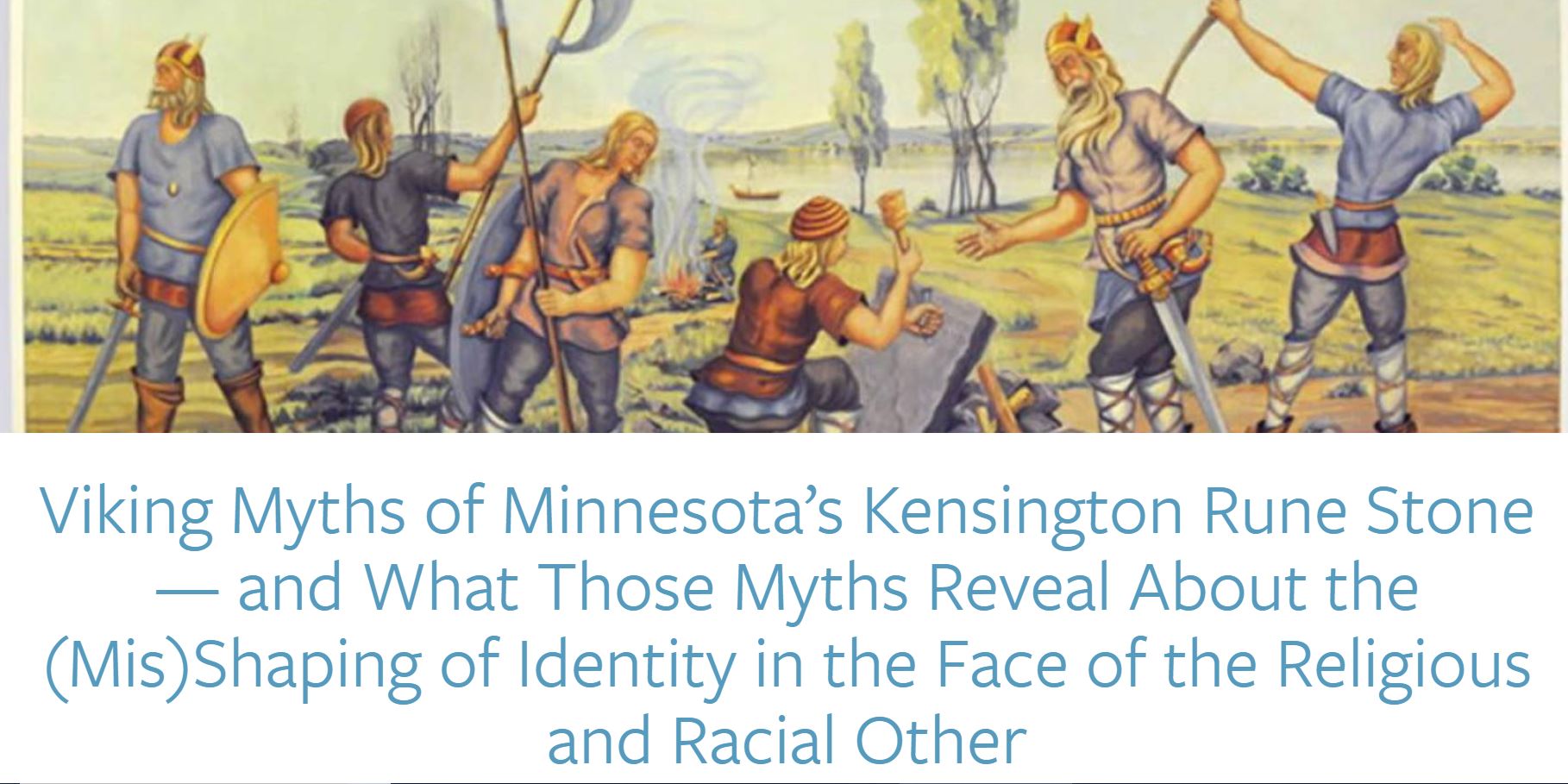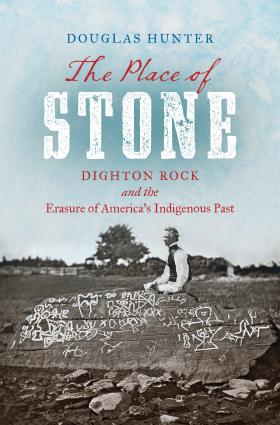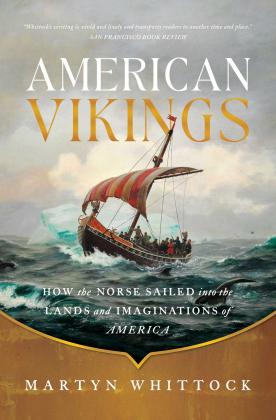A new book by Martyn Whittock, American Vikings: How the Norse Sailed into the Lands and Imaginations of America, tells the story of how notions of a Viking presence in pre-Columbian America have been an enduring part of American culture since the 18th century. Similar to my book, Myths of the Rune Stone: Viking Martyrs and the Birthplace of America, Whittock discusses several factors that fueled this interest, including the translation of the Viking Sagas into English in the mid-19th Century, the mass immigration of Norwegians and Swedes in the late 19th century, and an ongoing effort by white people to assert a European claim to the landscape. After I read the book, I will add some more thoughts to this post. For now, check out Whittock’s essay in Slate.
Uncategorized
Fall 2018 Book Tour: Viking Myths & What They Reveal About the (Mis)Shaping of Identity in the Face of the Religious and Racial Other

My book, Myths of the Rune Stone: Viking Martyrs and the Birthplace of America, was published by the University of Minnesota Press three years ago. I’m pleased the book is still getting attention and I look forward to several upcoming events.
My first stop will be in Uppsala, SWEDEN for the The 19th Biennial Conference for the International Society for Religion, Literature and Culture held at Uppsala University from September 28-30. The theme of the conference this year is “The Place of Truth” and I’ll be presenting a paper titled “The Sacralization of the Kensington Rune Stone: Constructing a Myth of America’s Birth.” This will be for the Material Religion section. Thanks to S. Brent Plate, the editor of the Material Religion journal for hosting this session.
During the first week of October, I’ll be headed to MINNESOTA for a series of three lectures sponsored by the Jay Phillips Center for Interfaith Learning at the University of St. Thomas. Dr. Hans Gustafson reached out to me several months ago after he had read a copy of Myths of the Rune Stone. The series we come up with is entitled “Viking Myths of Minnesota’s Kensington Rune Stone — and What Those Myths Reveal About the (Mis)Shaping of Identity in the Face of the Religious and Racial Other.”
- October 3 @ 12:15 pm: University of St. Thomas in St. Paul, MN
- October 3 @ 7:00 pm: American Swedish Institute in Minneapolis, MN
- October 4 @ 4:30 pm: St. John’s University in Collegeville, MN
On October 23, I’ll be traveling to Franklin and Marshall College in Lancaster, Pennsylvania to speak to Dr. Mary Ann Levine’s anthropology course entitled “Great Mysteries of the Past.” Dr. Levine’s course explores frauds and hoaxes, the difference between science and pseudoscience, and argument vs. assertion.
Finally, I’ll be traveling to Sarah Lawrence College on Monday, December 10 in New York to participate in an afternoon seminar in conjunction with Professor Irene Elizabeth’s Stroud‘s class “American Religious Mythmaking: The Stories We Tell Ourselves.”
Review of: The Place of Stone: Dighton Rock and the Erasure of America’s Indigenous Past
 The Place of Stone: Dighton Rock and the Erasure of America’s Indigenous Past. By Douglas Hunter. Chapel Hill: The University of North Carolina Press, 2017.
The Place of Stone: Dighton Rock and the Erasure of America’s Indigenous Past. By Douglas Hunter. Chapel Hill: The University of North Carolina Press, 2017.
This review was recently published in
In the early nineteenth century, Joseph Smith claimed that he unearthed golden plates in a New York hillside that told the story of a Lost Tribe of Israel’s journey to America. In the early twentieth century, rural Minnesotans used a stone with a runic inscription to argue that Norsemen visited the region long before the voyages of Columbus. Even today, the popularity of television shows such as Ancient Aliens and America Unearthed demonstrate that many are still on the look-out for alternative theories about pre-Columbian America. Douglas Hunter’s book,The Place of Stone, uses the history of the Dighton Rock to explain the motivations behind the centuries-long belief that North America was…
View original post 838 more words
Skype Meeting with NDSU Class “Magic and Religion”
Last week, I had the privilege of participating in a Skype conversation with a North Dakota State University class about my book, Myths of the Rune Stone: Viking Martyrs and the Birthplace of America. Professor Alexander Hsu, a PhD Candidate at University of Chicago in the History of Religions, used the book in his course “Magic and Religion.”
Professor Hsu’s students were really terrific, and we had a fascinating discussion. Many students saw the book as a an important historical analysis that offered perspective on contemporary racial justice movements and debates over immigration.
Most of the students were from the region. I will post the syllabus and other details soon.
O. Fritiof Ander Lecture: “American Rune Stone— Monument, Memorial and Myth”
On October 7, 2017, I had the privilege of delivering the annual O. Fritiof Ander Lecture on immigration history. The lecture is sponsored by the Swenson Swedish Immigration Research Center located at Augustana College in Rock Island, Illinois. I was invited by Professor Dag Blanck, the director of the Swenson Center. I have been a fan of Dag’s research on Swedish American identity for many years, but I had the privilege of meeting him at the Society for Advancement of Scandinavian Study conference earlier in 2017.
When Dag gave the introduction before my lecture, he noted that this was the second Ander lecture focused the Kensington Rune Stone. The first was delivered by Professor Henrik Williams from Uppsala University. Henrik is perhaps the world’s leading expert on runic inscriptions. His talk focused on the language of the inscription on the rune stone. His conclusion is that inscription was mostly like produced by residents near Kensington, Minnesota in the late nineteenth century.
The focus of my research is on the reasons that so many have persisted in believing that the Kensington Rune Stone to be an authentic artifact from the fourteenth century, despite evidence to the contrary. My lecture outlines many of the themes in my book, but ended my talk by discussing ways that I think the history of the Kensington Stone is relevant to contemporary discussions about the increasing popularity of fringe history and its relationship to notions of white supremacy.
Representing the True Believer in Scholarship and Film
Did Viking reach what is now Minnesota prior to the explorations of Christopher Columbus in 1492? We know for certain that Vikings did indeed spend time in North America around the year 1000. An archaeological site unearthed at L’Anse Aux Meadows in Canada’s province of Newfoundland is proof. However, scores of Midwestern Americans have claimed that Vikings didn’t stop there. They assert that an inscribed artifact known as the Kensington Rune Stone proves that Scandinavians had reached the heart of the continent by 1362.
Although most professional geologists, linguists, and historians have concluded that the runic inscription is most likely a product of the nineteenth century, many Minnesotans have persisted in this belief. The faithful have frequently been portrayed by journalists, scholars, and filmmakers in a pejorative light. In the 1970s, a British TV producer, Brian Branston, spent time in Minnesota researching the popular enthusiasm for the Kensington Rune Stone. Here’s how he described believers in the artifact’s authenticity:
Those who believe it bogus rest their case on the arguments of reputable scholars, particularly linguists and runologists who are practically unanimous in declaring the inscription a hoax. Those who believe in the genuineness of the inscription hold on to their beliefs much as one would hold to a religious faith. You cannot reason with faith.
Is belief in something that contradicts scientific evidence inherently irrational? This is a question that scholars of religion have long debated. Some, like Sigmund Freud, considered religious belief to be the product of neurosis. However, to write off people’s beliefs as nothing more than mental illness obscures more than it reveals. To do so is to miss the opportunity to understand how beliefs function for the persons who hold them. As another scholar, Daniéle Hervieu Léger, has observed, science does not always satisfy “the human need for assurance, which is at the source of the search to make life intelligible and which constantly evokes questions of why.”
Earlier this year, when my book Myths of the Rune Stone was in the final stages of production, I came across a Facebook page associated with a new documentary film called “Lost Conquest.” The film opens with the statement, “One thousand years ago, Vikings visited Minnesota. Or Not. It kind of depends on who you ask.” I was delighted to find out that another Minnesota native, Mike Scholtz, had seriously considered the meaning of the popular enthusiasm for Viking origin myths.
Mike’s film Lost Conquest highlights several colorful characters offering perspective on the question of whether or not Viking visitors explored what would one day become Minnesota. One Viking researcher clearly relished his role as a non-conformist thinker who questioned mainstream beliefs about American history. When asked why scholars did not embrace his theory that Vikings visited Minnesota, he declares that they were probably threatened because “That kind of leaves old Columbo [sic] out of the picture!” Another enthusiast who manages a Viking-themed bed and breakfast fires off several hilarious anti-Green Bay Packers jokes before expressing his doubts that the stone’s discover Olof Ohman could have lived a lie for his whole life. Yet another rune stone believer parallels the skepticism toward the authenticity of the Kensington Rune Stone with the modern skepticism towards Christianity. “Your’re always going to have skeptics…but God has given the human race free will.”
To believers in the Kensington Rune Stone, including the enthusiasts portrayed in Lost Conquest, there has been a lot at stake in the question of whether or not Viking visited Minnesota. Immigrants from Sweden and Norway believed that if their ancestors had visited North America, it would prove that they truly belonged in their new Minnesota home. Civic boosters used the Viking narrative to prove that their region of Minnesota was historically significant and the true “Birthplace of America.” More perniciously, many interpreted the inscription’s story about Vikings found “red with blood and dead” as evidence the Native Americans had always been irredeemably savage and it was, therefore, justified that Dakota people were expelled from the state in the 1860s.
Lost Conquest paints a sympathetic yet critical portrait of contemporary believers in one of Minnesota’s most powerful myths of origin. The film not only sheds light on the genesis and propagation of local folklore, it raises larger questions about the nature of religious belief itself.
To find out where Lost Conquest is playing next, click on the Facebook page link in the text above. Lost Conquest makes a fine viewing companion before or after you read Myths of the Rune Stone: Viking Martyrs and the Birthplace of America. Please be in contact if you would like to interview one or both of us.
